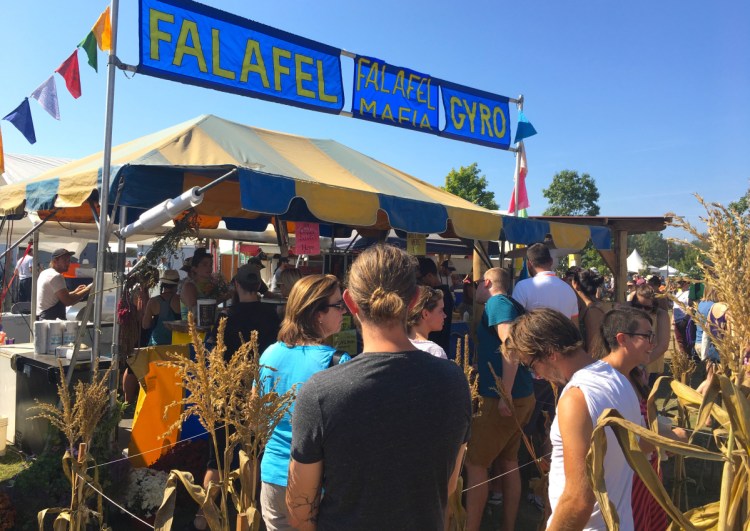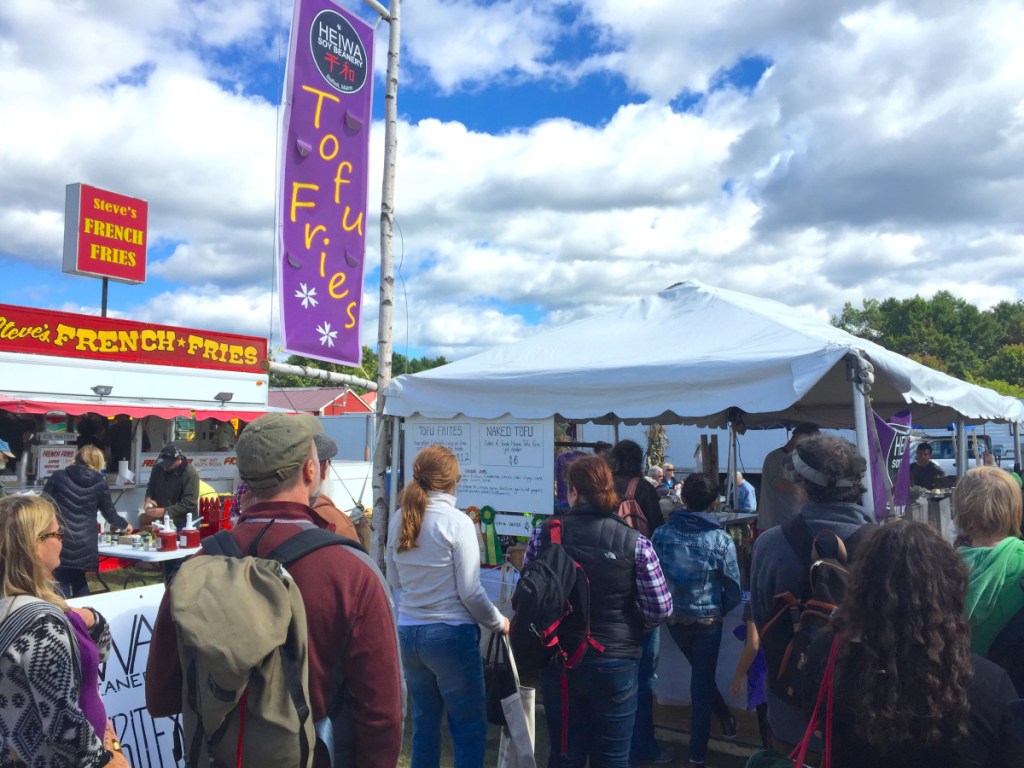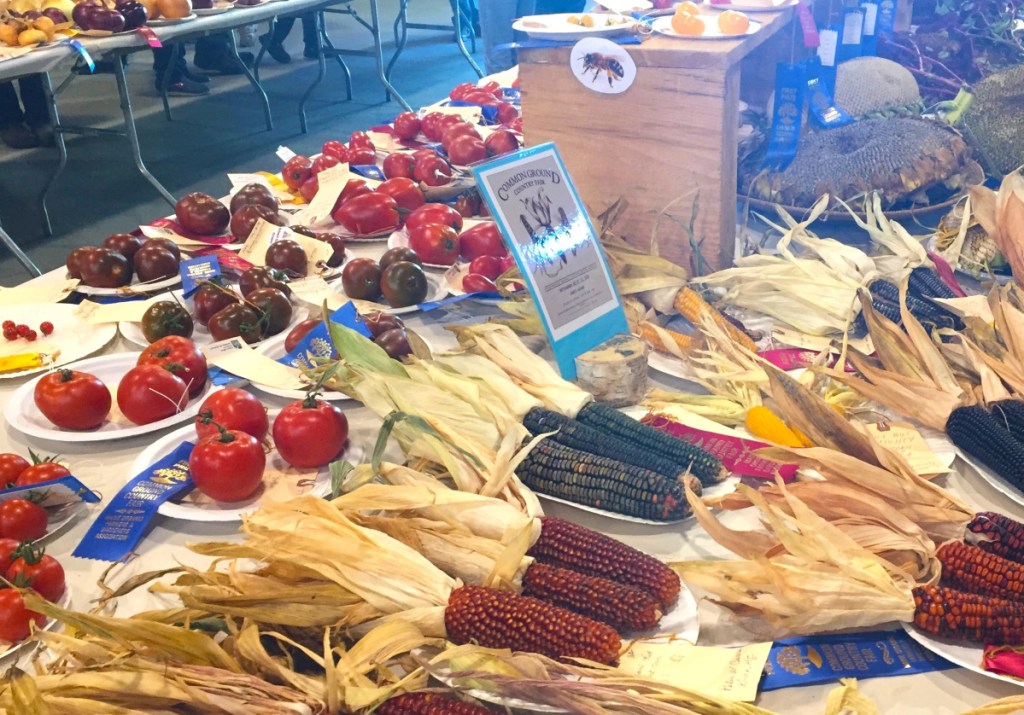Entering through the stone Rose Gate at the Common Ground Country Fair, I feel it immediately.
It’s a visceral sensation formed by the heady scent of the fair’s signature herb Sweet Annie (carried in bouquets and worn as crowns) mixing with the faint smell of wood smoke and fried potatoes; the clang of the forger’s hammer punctuating the live bluegrass music; the mosaic of vegetables, crafts and art that spins out in all directions; and finally the taste of every exquisite morsel of organic, vegan food I can get my hands on.
For three fleeting days Sept. 21-23, the Maine Organic Farmers and Gardeners Association holds its major annual fundraiser with strict rules about what kind of food (all organic and preferably local) can be sold.
The fair began in 1977 and has always been a place to learn about organic agriculture, self-sufficiency, solar power, herbal medicine, green living and meat-free food. Today it’s easy to forget that in the 1970s these were all considered counterculture ideas.
I attended the first Common Ground Country Fair at age 4. In the years since, I’ve followed the fair as it outgrew the fairgrounds in Litchfield and then Windsor before taking up permanent residence at the more than 300-acre MOFGA campus in Unity. Along the way, I’ve learned how to get the most out the event. Here are 10 tips for a successful, plant-powered visit to the Common Ground Fair.
1. MAKE A PLAN
The Common Ground Country Fair is a huge event both in terms of physical size and the number of activities. You cannot do and see it all in one day, so make a plan. Some things to consider: Do you want to spend time browsing the 388 artisan booths? Or listening to the hundreds of speakers? Or exploring the plant-based modern art in the Maine Indian Basketmakers tent? Or learning about herbal medicine in the Herb Tent? Or maybe, like me, your primary goal is sampling as much vegan food as possible? Figure out where you want to spend the bulk of your time, and then fit the other things you want to do around that.
2. MAP OUT YOUR VISIT
Your next task is to figure out how to get to the fairgrounds. The MOFGA website helps arrange carpooling, offers details on where to park and then bike to the fair (save $2), and lists adult education programs taking buses to the fair. For those driving from southern Maine, you either exit I-95 in Augusta or Waterville and enter the fair on the Thorndike side (Pine Gate), or you exit the highway in Fairfield and enter the fair on the Unity side (Rose Gate). An antique train leaves from both Unity and Thorndike and can take you the last few miles.
Since the fairgrounds are large and get crowded at midday, you’ll spend less time zig-zagging across them if you take the time now to study the map (online or in the 2018 fair book). Note the location of the food courts, the five live music stages, the Exhibition Hall, the MOFGA Country Store, The Common and the restrooms. If you plan to hear a talk or attend an event, locate where it will happen. If you have kids, note the location of the Children’s Area and the Farm & Homestead Kids’ Tent.
3. LEAVE EARLY
To avoid the traffic jams that turn the rural roads leading to the fairground’s entrances into parking lots, you need to leave early. The busiest time at the fair is midday. Without traffic, it takes a little less than two hours to get to Unity from Portland. With traffic, it can take much more. Over the years, I’ve tried going at various times, but the only consistent way I’ve found to avoid the worst of the traffic is to leave Portland shortly after 7 a.m. and arrive just as the fair gates open at 9 a.m. MOFGA advises visitors to arrive before 10 a.m. or after 1:30 p.m.
4. KNOW WHAT TO EAT
You can find vegan food at many booths in both food courts on either side of The Common. Some of my favorites include the falafel sandwich from Falafel Mafia (a long-time Common Ground vendor now known for its all-vegan food truck in Portland); the tofu fries from Heiwa Tofu (they’re soaked in brine before being deep fried); and the tofu stir fry and smoothies from the Solar Cafe. Also look for veggie burgers, fries, wood-fired pretzels, tempura, Indian dishes, baked beans, harvest stew, eggplant sandwiches, salads, and the fruit-filled Pie Cones.
5. VISIT THE EXHIBITION HALL
Whether you stop to read every description or just do a quick walk through on your way to the restroom, it’s worth a visit to the fair’s all-organic display of prize-winning edible and decorative plants. You’ll see lots of lesser known and heirloom varieties, and the seed swap is located here, too.
6. VISIT BOTH FARMERS MARKETS
An all-organic farmers market flanks each entrance, the only two of their kind in the state. Depending where you park, one will be easy to visit, but the other you’ll have to seek out on the opposite side of the fairgrounds. The Rose Gate market is the bigger of the two, and both are stocked with fresh vegetables and herbs, alongside more specialty items such as flours, grains, dried beans, canned goods, maple syrup and apple cider. The farmers markets are the spot to buy Sweet Annie.
7. GET A POSTER OR T-SHIRT
The MOFGA Country Store, located next to the Exhibition Hall, is where to find the iconic posters and T-shirts that pop up all over Portland in the fall. If you show up early, go here first. Otherwise expect to wait in a long line to purchase this year’s shopping bags, aprons, and note cards. The pigs featured in this year’s image are not being raised for meat. Artist Arika von Edler of San Francisco has said she painted the image of two kunekune pigs to call attention to “heirloom livestock outside of meat consumption.” The pigs live on a homestead in Washington County and help turn the forest into farmland.
8. LEARN SOMETHING NEW
Part of the Common Ground experience is learning new skills and considering new ideas, and the 794 educational talks, discussions and demonstrations are where this happens. Keynote speakers talk on The Common each day at 11 a.m., and a Public Policy Teach-In on Saturday at 1 p.m. will discuss Maine’s agricultural policy. Some plant-based highlights among the events include the heritage apple tastings with John Bunker of Fedco Trees (4 p.m. Friday and Saturday); an advanced seed-saving class with veganic farmer Will Bonsall (11 a.m. Friday); the daily cider pressing in the Farm & Homestead Kids Tent (various times); a talk on the History of Maine Herbology (9 a.m. Saturday); a primer on how to create an edible landscape (10 a.m. Sunday); a discussion of fruit exploring (11 a.m. Sunday); and a demonstration of how to make veganic fertilizer (3:30 p.m. Sunday).
9. WATCH A PARADE
Each day at 10:30 a.m. and 2:30 p.m., the delightfully plant-positive Children’s Garden Parade does a loop around The Common. Other parades at the fair are more spontaneous, but you can usually count on seeing a bike parade. The roving bands of folk musicians add to the fair’s unique flavor.
10. ADMIRE THE LANDSCAPE
Realize that when visiting the Common Ground Country Fair you’re not just going to a fair; you’re visiting a working botanical garden that offers insights into Maine’s organic farming and gardening heritage. Flower gardens and demonstration vegetable plots are scattered across the fairgrounds. Admire the heirloom apple trees in the North Orchard. Or view diverse fruit trees including plums and cherries in the South Orchard. Look for the hoop houses, the hugelkultur beds, the AgrAbility planters, the Peace Garden, the Sundial Garden, the Common Kitchen Herb Garden and Johnny’s Selected Seeds display gardens. Those coming and going from the Pine Gate will enjoy a tranquil walk through a corner of the Low Impact Forestry Wood Lot, where you take the well-shaded Woods Trail to get to the fair.
Avery Yale Kamila is a food writer who lives in Portland. She can be reached at
avery.kamila@gmail.com
Twitter: AveryYaleKamila
Send questions/comments to the editors.





Comments are no longer available on this story